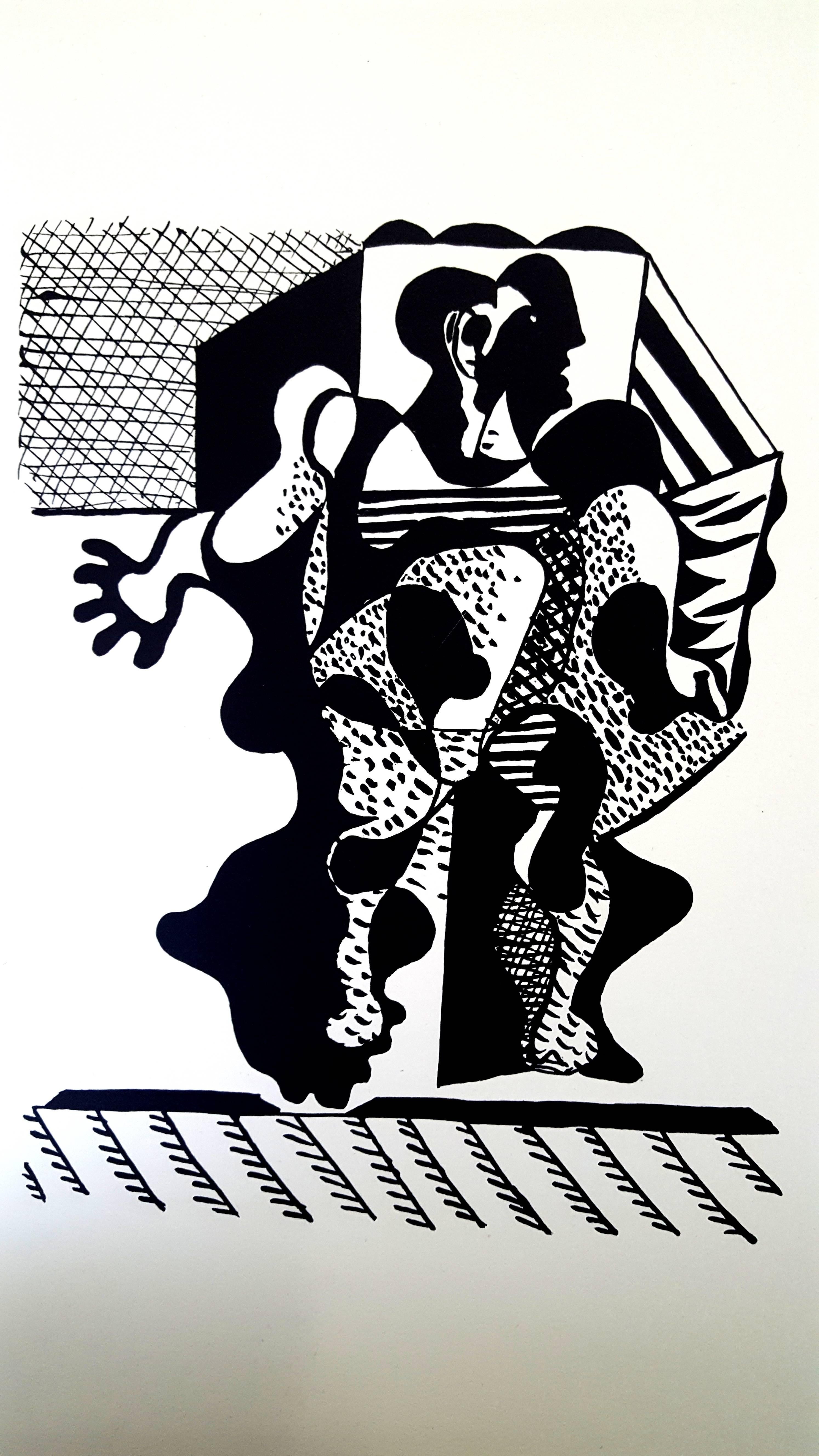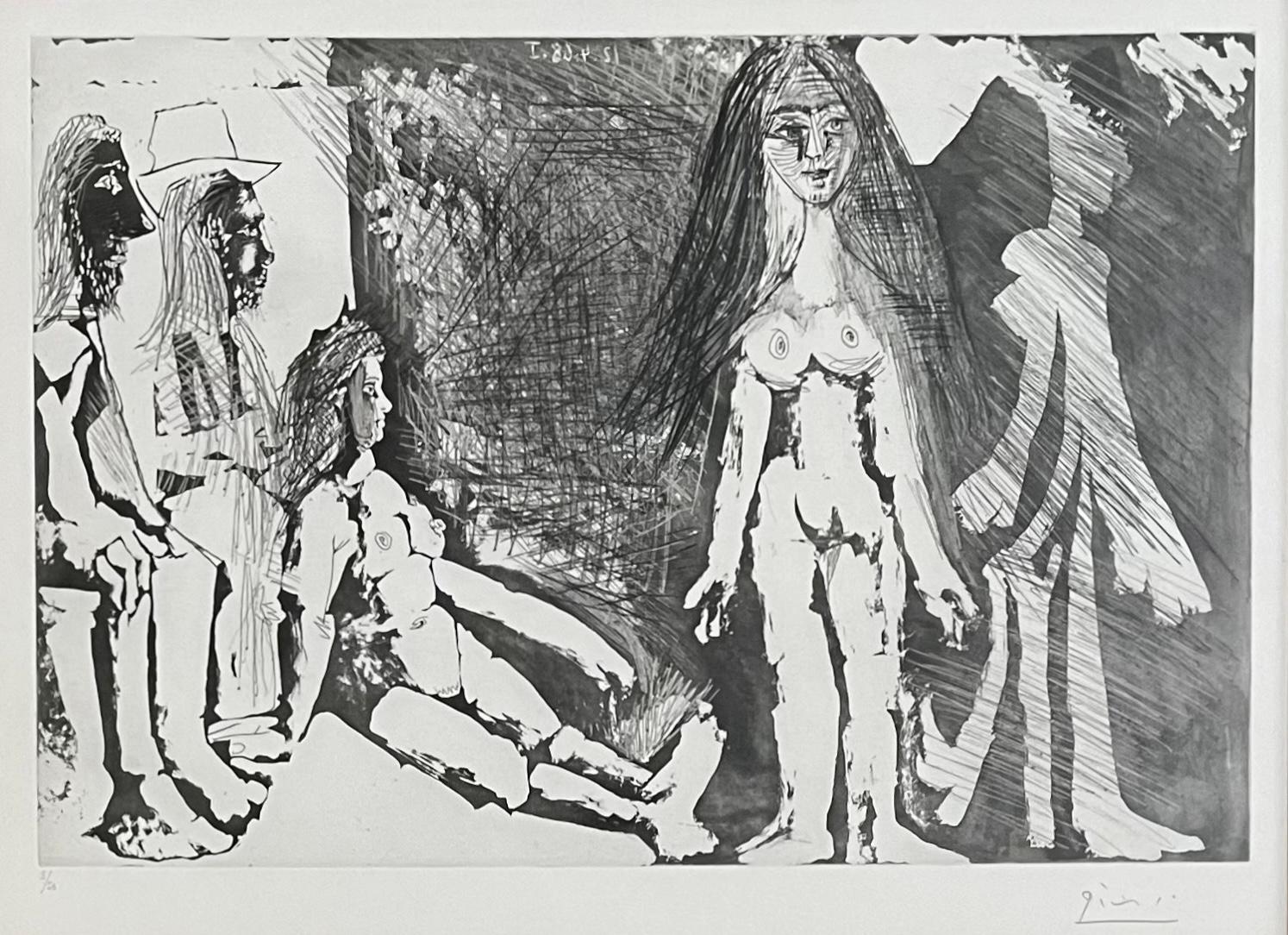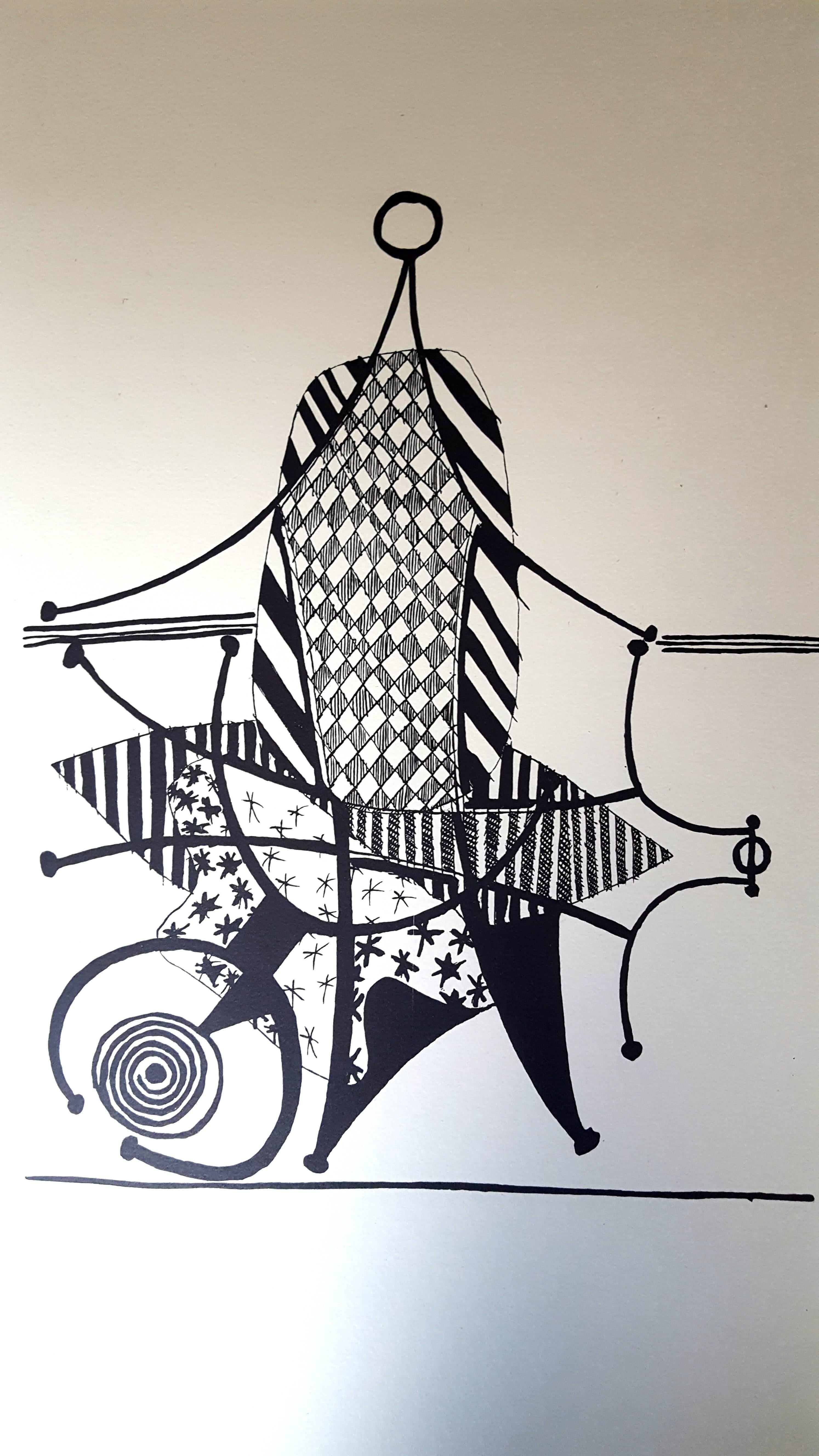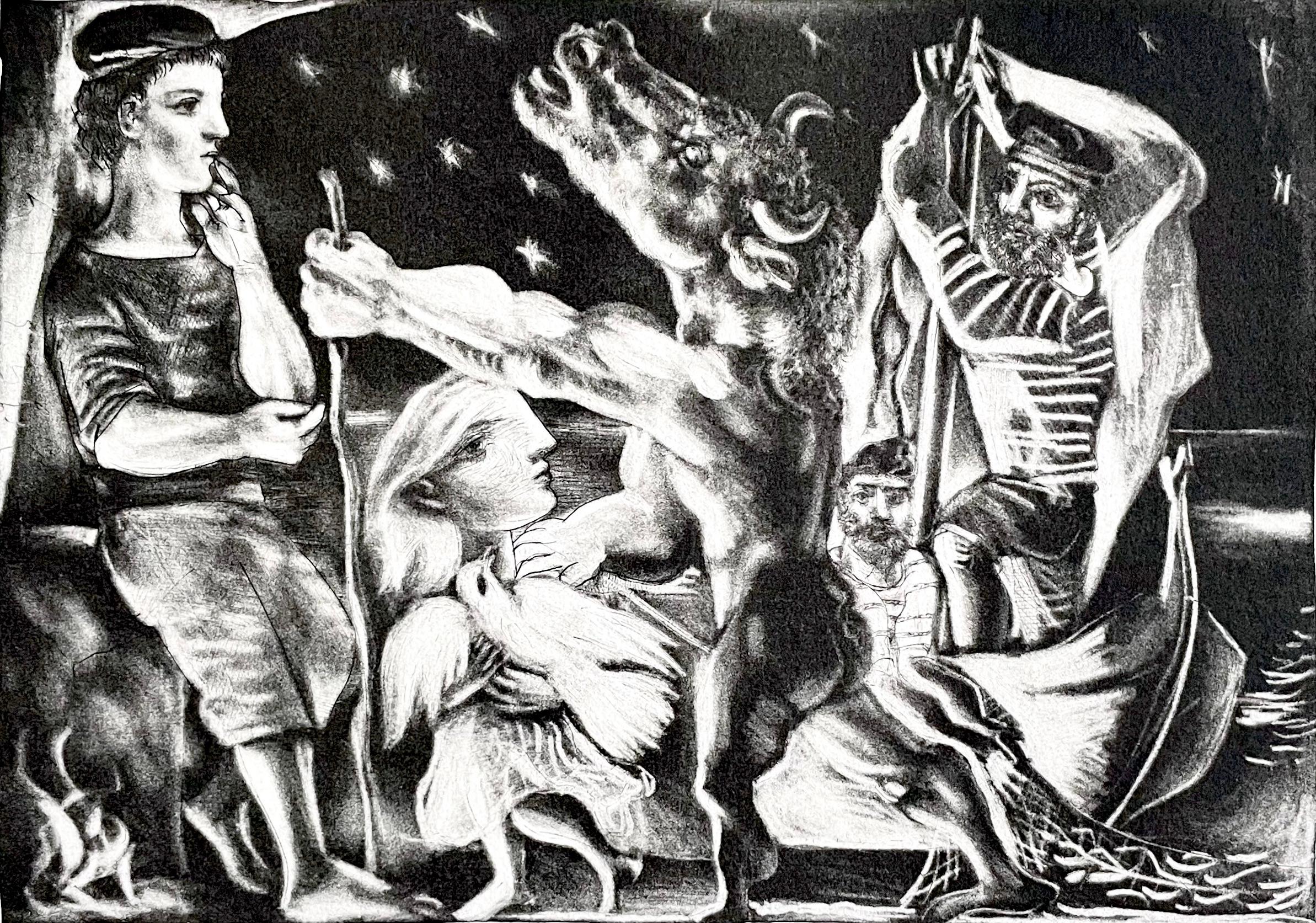Items Similar to Pablo Picasso (after) Helene Chez Archimede - Wood Engraving
Want more images or videos?
Request additional images or videos from the seller
1 of 10
(after) Pablo PicassoPablo Picasso (after) Helene Chez Archimede - Wood Engraving1955
1955
About the Item
Pablo Picasso (after)
Helene Chez Archimede
Medium: engraved on wood by Georges Aubert
Dimensions: 44 x 33 cm
Portfolio: Helen Chez Archimede
Year: 1955
Edition: 240 (Here it is one of the140 reserved for the members of the New Paris Circle of the book and its collaborators (No. 58, printed for Alexandre Loewy)
Pablo Picasso
Picasso is not just a man and his work. Picasso is always a legend, indeed almost a myth. In the public view he has long since been the personification of genius in modern art. Picasso is an idol, one of those rare creatures who act as crucibles in which the diverse and often chaotic phenomena of culture are focussed, who seem to body forth the artistic life of their age in one person. The same thing happens in politics, science, sport. And it happens in art.
Early life
Born in Malaga, Spain, in October of 1881, he was the first child born in the family. His father worked as an artist, and was also a professor at the school of fine arts; he also worked as a curator for the museum in Malaga. Pablo Picasso studied under his father for one year, then went to the Academy of Arts for one year, prior to moving to Paris. In 1901 he went to Paris, which he found as the ideal place to practice new styles, and experiment with a variety of art forms. It was during these initial visits, which he began his work in surrealism and cubism style, which he was the founder of, and created many distinct pieces which were influenced by these art forms.
Updates in style
During his stay in Paris, Pablo Picasso was constantly updating his style; he did work from the blue period, the rose period, African influenced style, to cubism, surrealism, and realism. Not only did he master these styles, he was a pioneer in each of these movements, and influenced the styles to follow throughout the 20th century, from the initial works he created. In addition to the styles he introduced to the art world, he also worked through the many different styles which appeared, while working in Paris. Not only did he continually improve his style, and the works he created, he is well known because of the fact that he had the ability to create in any style which was prominent during the time.
Russian ballet
In 1917, Pablo Picasso joined the Russian Ballet, which toured in Rome; during this time he met Olga Khoklova, who was a ballerina; the couple eventually wed in 1918, upon returning to Paris. The couple eventually separated in 1935; Olga came from nobility, and an upper class lifestyle, while Pablo Picasso led a bohemian lifestyle, which conflicted. Although the couple separated, they remained officially married, until Olga's death, in 1954. In addition to works he created of Olga, many of his later pieces also took a centralized focus on his two other love interests, Marie Theresa Walter and Dora Maar. Pablo Picasso remarried Jacqueline Roque in 1961; the couple remained married until his death 12 years later, in 1973.
Work as a pacifist
Pablo Picasso was a pacifist, and large scale paintings he created, showcased this cry for peace, and change during the time. A 1937 piece he created, after the German bombing of Guernica, was one such influential piece of the time. Not only did this become his most famous piece of art work, but the piece which showed the brutality of war, and death, also made him a prominent political figure of the time. To sell his work, and the message he believed in, art, politics, and eccentricity, were among his main selling points.
Conflicting with social views
Many things Pablo Picasso did during the 1950s, conflicted with the general public. Viciousness towards his children, exaggerated virility towards women, and joining the Communist party, were some of the many scandals which he was involved in during his lifetime. Although most of the things he did were viewed negatively by a minority of the general public, admirers of Pablo Picasso turned a blind eye, and still accepted him as a prominent figure in their society. Following the end of WWII, Pablo Picasso turned back towards his classic style of work, and he created the "Dove of Peace." Even though he became a member of the Communist party, and supported Stalin and his political views and rule, Pablo Picasso could do no wrong. In the eyes of his admirers and supporters, he was still a prominent figure, and one which they would follow, regardless of what wrongs he did. He was not only an influence because of the works he created, but he was also an influential figure in the political realm.
Influence outside of art
Although Pablo Picasso is mainly known for his influence to the art world, he was an extremely prominent figure during his time, and to the 20th century in general. He spread his influences to the art world, but also to many aspects of the cultural realm of life as well. He played several roles in film, where he always portrayed himself; he also followed a bohemian lifestyle, and seemed to take liberties as he chose, even during the later stages of his life. He even died in style, while hosting a dinner party in his home.
Collection of work
Pablo Picasso is recognized as the world's most prolific painter. His career spanned over a 78 year period, in which he created: 13,500 paintings, 100,000 prints and engravings, and 34,000 illustrations which were used in books. He also produced 300 sculptures and ceramic pieces during this expansive career. It is also estimated that over 350 pieces which he created during his career, have been stolen; this is a figure that is far higher than any other artist throughout history.
Sale of his works
Pablo Picasso has also sold more pieces, and his works have brought in higher profit margins, than any other artist of his time. His pieces rank among the most expensive art works to be created; with a price tag of $104 million, Garson a la Pipe, was sold in 2004.
Although he had a conflicting lifestyle, Pablo Picasso was admired by many, and was one of the most influential figures of his time. Not only during his life, but also after his death, he is still one of the most well known artists, and political figures, of his time. With thousands of pieces to his name, and art works which have been seen by millions, around the world, he has been a great influence to society, he has influenced the art world, and he introduced many new styles of art, which helped shape modern art, and modern styles artists follow today.
- Creator:(after) Pablo Picasso (1881 - 1973, Spanish)
- Creation Year:1955
- Dimensions:Height: 17.33 in (44 cm)Width: 13 in (33 cm)Depth: 0.04 in (1 mm)
- Medium:
- Movement & Style:
- Period:
- Condition:
- Gallery Location:Collonge Bellerive, Geneve, CH
- Reference Number:1stDibs: LU16121879393
About the Seller
4.9
Platinum Seller
These expertly vetted sellers are 1stDibs' most experienced sellers and are rated highest by our customers.
Established in 2015
1stDibs seller since 2015
907 sales on 1stDibs
Typical response time: 1 hour
- ShippingRetrieving quote...Ships From: Collonge Bellerive, Geneve, Switzerland
- Return PolicyA return for this item may be initiated within 7 days of delivery.
More From This SellerView All
- Pablo Picasso (after) Helene Chez Archimede - Wood EngravingBy (after) Pablo PicassoLocated in Collonge Bellerive, Geneve, CHPablo Picasso (after) Helene Chez Archimede Medium: engraved on wood by Georges Aubert Dimensions: 44 x 33 cm Portfolio: Helen Chez Archimede Year: 1955 Edition: 240 (Here it is on...Category
1950s Cubist Figurative Prints
MaterialsEngraving, Woodcut
- Pablo Picasso (after) Helene Chez Archimede - Wood EngravingBy (after) Pablo PicassoLocated in Collonge Bellerive, Geneve, CHPablo Picasso (after) Helene Chez Archimede Medium: engraved on wood by Georges Aubert Dimensions: 44 x 33 cm Portfolio: Helen Chez Archimede Year: 1955 Edition: 240 (Here it is on...Category
1950s Cubist Figurative Prints
MaterialsEngraving
- Decameron - Portfolio of 10 Original Signed Engravings by Salvador DaliBy Salvador DalíLocated in Collonge Bellerive, Geneve, CHPortfolio of 10 Original Signed Engravings by Salvador Dali Title: Decameron Signed in Pencil by Salvador Dali Dimensions: 45 x 32 cm Edition EA 1/5 1972 References : Field 72-8 (p. ...Category
1970s Surrealist Figurative Prints
MaterialsEngraving
- Salvador Dali - Albert Schweitzer - Original Handsigned EngravingBy Salvador DalíLocated in Collonge Bellerive, Geneve, CHSalvador Dali - Albert Schweitzer - Original Handsigned Engraving Dimensions: 17.5 x 12.5 cm 1970 Signed in pencil EA Jean Schneider, Basel Reference...Category
1960s Surrealist Nude Prints
MaterialsEngraving
- Salvador Dali - Enrico Fermi - Original Handsigned EngravingBy Salvador DalíLocated in Collonge Bellerive, Geneve, CHSalvador Dali - Enrico Fermi - Original Handsigned Engraving Dimensions: 17.5 x 12.5 cm 1970 Signed in pencil EA Jean Schneider, Basel References : Field 70-5Category
1960s Surrealist Nude Prints
MaterialsEngraving
- Salvador Dali - Louis Pasteur - Original Handsigned EngravingBy Salvador DalíLocated in Collonge Bellerive, Geneve, CHSalvador Dali - Louis Pasteur - Original Handsigned Engraving Dimensions: 17.5 x 12.5 cm 1970 Signed in pencil EA Jean Schneider, Basel References : Fiel...Category
1960s Surrealist Nude Prints
MaterialsEngraving
You May Also Like
- 347 Series (B. 1511; Ba. 1527), Pablo PicassoBy Pablo PicassoLocated in Fairfield, CTArtist: Pablo Picasso (1881-1973) Title: Jeune fille regardée par une vielle femme et deux hommes dont un gitan Year: 1968 Medium: Etching, aquatint and drypoint on Rives BFK paper Size: 12.5 x 18.5 (plate); 17.75 x 24.25 inches (paper); 20.25 x 30.25 inches (frame) Condition: Excellent Catalogue: B. 1511; Ba. 1527 Inscription: Signed and numbered in pencil Notes: Published by Galerie Louise Leiris, Paris, from the 347 Series. PABLO PICASSO (1881-1973) Spanish painter and sculptor is one of the most recognized figures of twentieth century art. During his artistic career, which lasted more than 75 years, he created thousands of works using all kinds of mediums. He changed art more profoundly than any other artist of his time. First famous for pioneering cubism, Picasso continued to develop his art with a pace and vitality comparable to the accelerated technological and cultural changes of the twentieth century. Each change embodied a radical idea, and might be said that Picasso lived several artistic lifetimes. ABOUT SELLER DO YOU HAVE ARTWORK TO SELL? WE ARE ACTIVELY SEEKING CONSIGNMENTS AND EXCEPTIONAL OBJECTS TO PURCHASE OUTRIGHT! Art Commerce...Category
1960s Cubist Nude Prints
MaterialsAquatint, Etching, Drypoint
- Baptism (or, Group of Ten Men – One Seated)By Arthur B. DaviesLocated in New York, NYArthur B. Davies (1862-1928), Baptism (or, Group of Ten Men – One Seated), drypoint on zinc, 1917, signed in pencil , printed in black on very thin laid paper. In very good condition...Category
1910s Cubist Figurative Prints
MaterialsDrypoint
- Picasso, La Bonne dans l'Atelier de Sculpture (after)By Pablo PicassoLocated in Fairfield, CTArtist: After Pablo Picasso (1881-1973) Title: La Bonne dans l'Atelier de Sculpture (after Bloch 184) Year: 1992 Medium: Reproduced from the original edition using the grain Autotype...Category
1990s Cubist Nude Prints
MaterialsLithograph
- Picasso, Minotaure aveugle guidé par une Fillette dans la Nuit (after)By Pablo PicassoLocated in Fairfield, CTArtist: After Pablo Picasso (1881-1973) Title: Minotaure aveugle guidé par une Fillette dans la Nuit (after Bloch 225) Year: 1992 Medium: Reproduced from the original edition using t...Category
1990s Cubist Nude Prints
MaterialsLithograph
- Picasso, Le Viol VII (after)By Pablo PicassoLocated in Fairfield, CTArtist: After Pablo Picasso (1881-1973) Title: Le Viol VII (after Bloch 202) Year: 1992 Medium: Reproduced from the original edition using the grain Autotype halftone screen process by Druck- und Verlag GmbH, 4200 Oberhausen, Germany; lithographically printed by Druck- und Verlag GmbH on japon handmade 200 g/sqm paper by created by Richard de Bas in Ambert, France and imported by Japico Drissler Feinpapiere, Frankfurt, Germany. Paper Size: 18 x 12.75 inches; a size slightly reduced from the original Vollard edition for differentiation Condition: Excellent Inscription: Artist’s signature posthumously lithographically reproduced from the original Vollard edition, and numbered in pencil by the curators of the Municipal Museum Mülheim an der Ruhr, Germany. 168/300. Notes: Published by Municipal Museum Mülheim an der Ruhr, Germany in cooperation with the Society for the Promotion of the museum in 1992 and the Fundación Picasso; printed by Plitt Druck- und Verlag GmbH, 4200 Oberhausen, Germany. The following is a German to English translation of the original text issued by the Municipal Museum Mülheim an der Ruhr, Germany in the following from which this graphic is a part, “In order to give a broad public access to this unique print work by Pablo Picasso in its entirety and at the highest quality level, the support group for the city. Museum Mülheim an der Ruhr initiated and significantly supported the new edition of the “Suite Vollard.” The reprint of the "Suite Vollard" includes a limited edition of 300 copies of 100 loose sheets each in a linen cassette. The copies were numbered from 1 to 300 on the leader sheet. The reproductions were produced in grain screen mode, a process in which which eliminates the traditional line grid and achieves maximum originality. The paper was hand-made specifically for this work by Richard de Bas in Ambert, France, one of the most traditional paper mills in Europe. The paper for the original edition also comes from this factory. The quality Blane narcisse, belin, 200 g/sqm was selected and imported from Japico Drissler Feinpapiere, Frankfurt. Reproduction and paper format has been slightly reduced compared to the original edition. The technical development and overall production was carried out by Plitt Druck- und Verlag GmbH, 4200 Oberhausen.” PABLO PICASSO (1881-1973) Spanish painter and sculptor is one of the most recognized figures of twentieth century art. During his artistic career, which lasted more than 75 years, he created thousands of works using all kinds of mediums. He changed art more profoundly than any other artist of his time. First famous for pioneering cubism...Category
1990s Cubist Nude Prints
MaterialsLithograph
- Picasso, Minotaure attaquant une Amazone (after)By Pablo PicassoLocated in Fairfield, CTArtist: After Pablo Picasso (1881-1973) Title: Minotaure attaquant une Amazone (after Bloch 195) Year: 1992 Medium: Reproduced from the original edition using the grain Autotype half...Category
1990s Cubist Nude Prints
MaterialsLithograph
Recently Viewed
View AllMore Ways To Browse
Paintings By Pablo Picasso
Rare Engravings
Roses Engravings
Rose Engraving
Dove Wood
Classic Engraving
Vintage Children Book Prints
1937 Picasso
African Engraving
Picasso Engraving
Ceramic By Pablo Picasso
Pablo Picasso Women
Russian Engraving
Engravings Russia
Wood Blinds
Picasso The Genius
Ballerina Print
Pablo Picasso Illustrations




